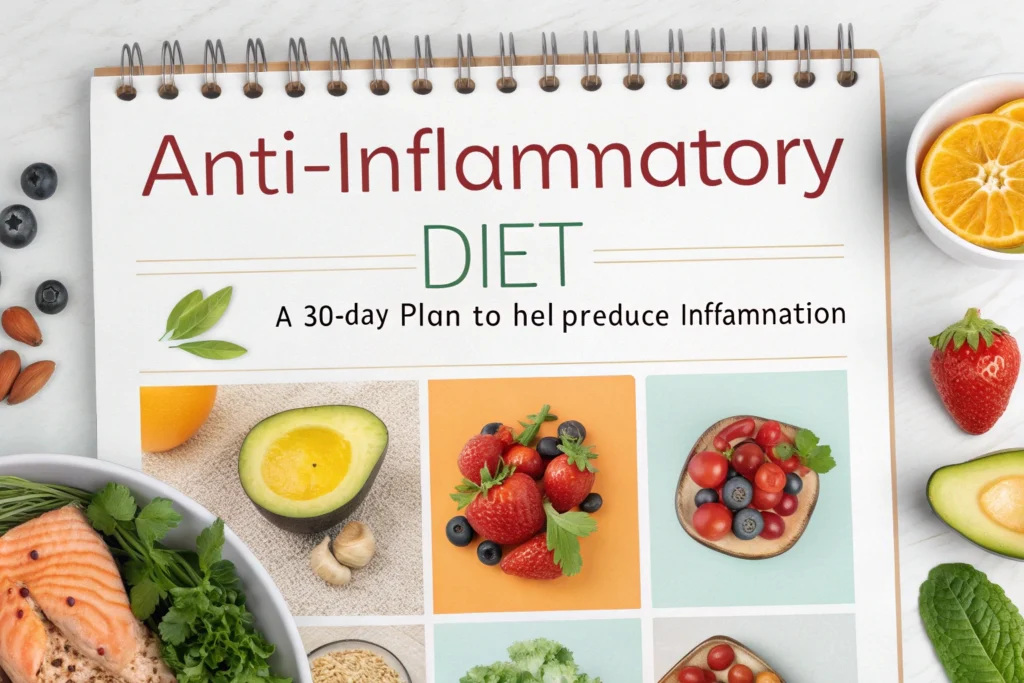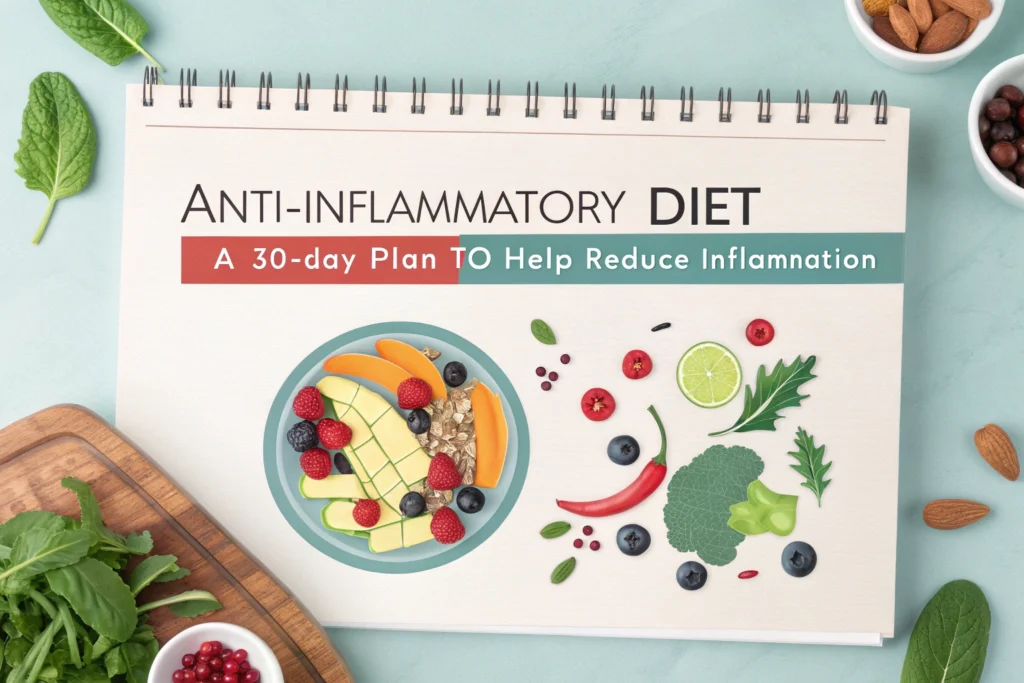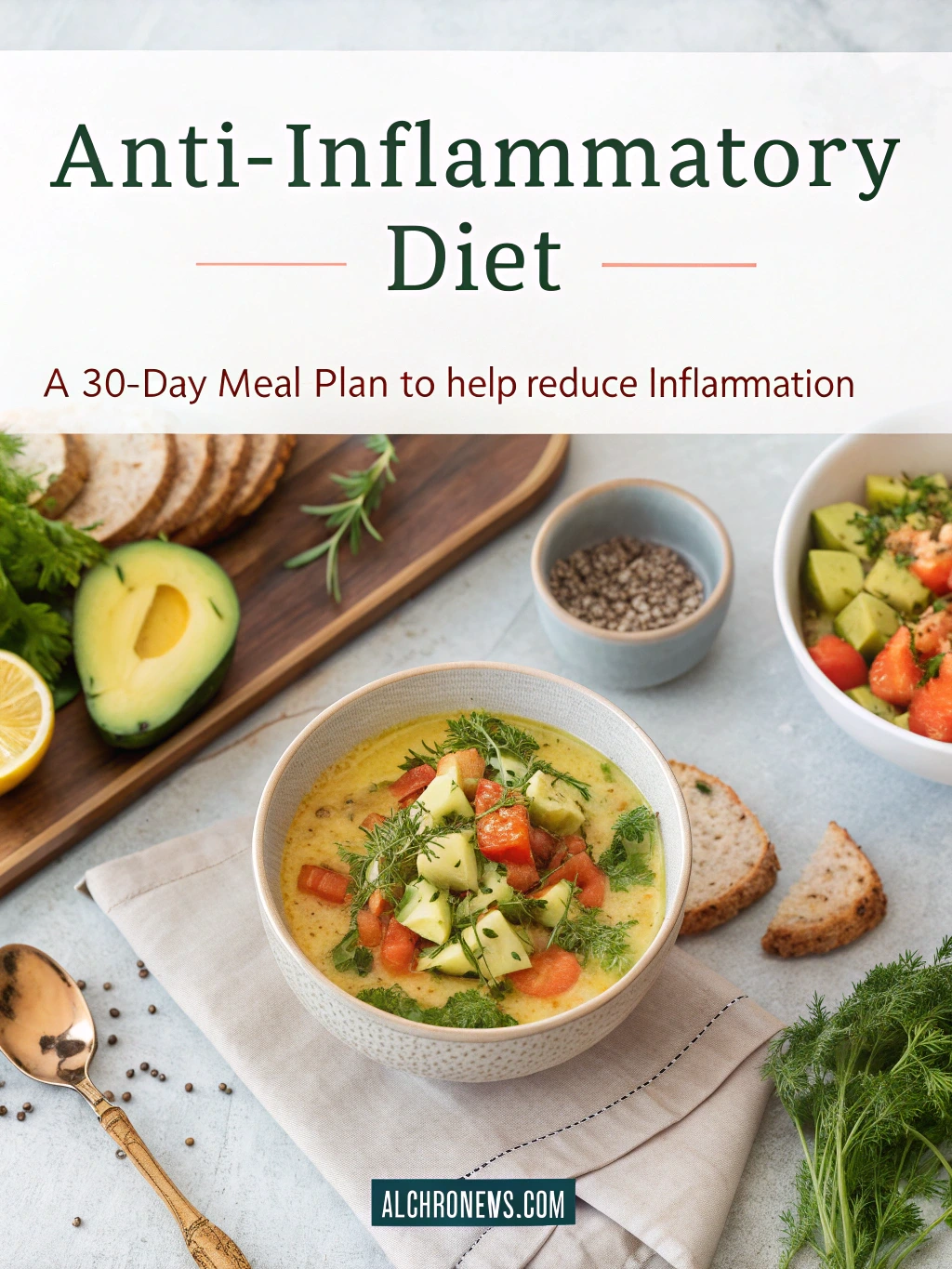Does each day feel like a battle against your own body? Those persistent aches, unexplained fatigue, and stubborn health issues might be whispering an important message: inflammation has silently taken residence within you.
Picture this: your favorite foods might actually be fueling an invisible fire inside your body. Chronic inflammation doesn’t announce itself with sirens—it simmers quietly, potentially contributing to everything from joint pain and digestive troubles to more serious health concerns. The good news? Your kitchen holds the power to extinguish these flames.
This comprehensive 30-day anti-inflammatory meal plan offers more than just recipes—it provides a roadmap to potentially transforming how you feel every single day. By strategically eliminating inflammatory triggers while embracing natural inflammation fighters, you might discover what countless others have: that food truly can function as medicine.
Table of contents

Understanding Inflammation: Your Body’s Double-Edged Sword
Inflammation itself isn’t your enemy—it’s actually an essential bodily function. When you cut your finger or catch a cold, acute inflammation rushes in as your protector, mobilizing your immune system to heal injuries and fight pathogens. This type of inflammation appears quickly, does its job, and resolves once the threat passes.
The problem develops when inflammation refuses to retreat. Chronic inflammation—persistent, low-grade, and often invisible—transforms from guardian to saboteur. Research consistently links this type of inflammation to numerous health conditions, from arthritis and digestive disorders to heart disease and even certain cancers.
“Many people don’t realize they’re experiencing chronic inflammation until significant damage has already occurred,” explains nutritionist Sarah Mitchell. “The beauty of an anti-inflammatory diet is that it addresses the root cause rather than merely masking symptoms.”
Your daily food choices significantly influence your inflammatory status. Modern Western diets, heavy in processed foods, refined carbohydrates, and certain oils, essentially provide constant inflammatory stimuli. Each ultra-processed meal, sugary snack, or fast food indulgence potentially contributes another log to your inflammatory fire.
The Science Behind Anti-Inflammatory Eating
This isn’t just nutritional philosophy—it’s backed by substantial scientific evidence. A 2022 review published in the Journal of Internal Medicine analyzed multiple studies and concluded that dietary patterns emphasizing colorful vegetables, omega-3 rich foods, and certain spices consistently demonstrated reduced levels of inflammatory biomarkers in participants.
Another landmark study in the American Journal of Clinical Nutrition followed participants who adopted Mediterranean-style eating patterns rich in anti-inflammatory components. After six months, researchers documented significant reductions in C-reactive protein (CRP) and interleukin-6—two key markers of systemic inflammation.
Why This 30-Day Anti-Inflammatory Diet Plan Works
Unlike quick-fix approaches, this month-long plan works systematically to reset your relationship with food. Here’s why this structured approach proves effective:
- Elimination phase: Systematically removes common inflammatory triggers, allowing your system to establish a true baseline
- Strategic reintroduction: Carefully brings various food groups back, helping identify your personal inflammatory triggers
- Nutrient density: Focuses on maximizing anti-inflammatory compounds rather than simply cutting foods out
- Sustainability: Builds habits gradually, increasing your likelihood of maintaining them beyond the 30 days
- Whole-food centered: Emphasizes naturally anti-inflammatory whole foods rather than supplements or processed “health” products
The plan balances scientific rigor with practical application. “Most people abandon restrictive diets because they’re simply too difficult to maintain,” notes Dr. Michael Chen, rheumatologist. “This plan succeeds because it introduces achievable changes while providing enough variety to prevent the dietary boredom that kills most health initiatives.”
Foods to Embrace and Avoid on an Anti-Inflammatory Diet
Understanding the inflammatory potential of various foods creates the foundation for successful implementation. This table highlights key players in both categories:
| Anti-Inflammatory Foods | Why They Help | Inflammatory Foods | Why They Harm |
|---|---|---|---|
| Fatty fish (salmon, sardines, mackerel) | Rich in omega-3 fatty acids that actively suppress inflammatory pathways | Processed foods | Contain artificial ingredients, preservatives, and additives that trigger inflammatory responses |
| Dark leafy greens (kale, spinach, collards) | High in antioxidants that neutralize free radicals | Refined carbohydrates | Spike blood sugar rapidly, promoting inflammation |
| Berries (blueberries, strawberries, blackberries) | Contain anthocyanins that downregulate inflammatory genes | Added sugars | Increase inflammatory markers and feed harmful gut bacteria |
| Turmeric | Contains curcumin, a compound showing comparable anti-inflammatory effects to certain medications | Fried foods | High in pro-inflammatory omega-6 fatty acids and AGEs (advanced glycation end products) |
| Extra virgin olive oil | Contains oleocanthal with similar effects to ibuprofen | Excessive alcohol | Damages gut barrier integrity, allowing inflammatory compounds to enter circulation |
| Tree nuts (walnuts, almonds) | Provide healthy fats and antioxidants that combat oxidative stress | Trans fats | Directly trigger inflammatory pathways even in small amounts |
| Avocados | Rich in monounsaturated fats and carotenoids that reduce inflammation | Processed meats | Contain preservatives and compounds that provoke inflammatory responses |
Your Complete 30-Day Anti-Inflammatory Diet Plan
Transforming your eating patterns requires structure and clarity. This four-week progression gradually reshapes your relationship with food while maximizing your chances of success.
Week 1: Reset and Reduce
Days 1-7: Focus on Elimination
The journey begins by creating distance between you and the most problematic inflammatory triggers. During this week:
- Remove processed foods, refined sugars, and fried items
- Decrease consumption of gluten-containing grains and dairy (common sensitivities)
- Begin integrating anti-inflammatory alternatives
- Establish baseline measurements for tracking your progress
Sample Day 1 Menu:
- Breakfast: Berry-turmeric smoothie with spinach and ground flaxseed
- Lunch: Mediterranean bowl with quinoa, chickpeas, cucumber, cherry tomatoes, and olive oil dressing
- Dinner: Baked wild-caught salmon with roasted sweet potatoes and steamed broccoli
- Snacks: Handful of walnuts; apple slices with unsweetened almond butter
During this initial week, you might experience mild detox symptoms as your body adjusts. Fatigue, headaches, or cravings sometimes emerge but typically resolve within days. “Consider these transitional discomforts as evidence your body is beginning to recalibrate,” suggests nutritional therapist Emma Watson.

Week 2: Rebuild and Reinforce
Days 8-14: Strengthening Anti-Inflammatory Habits
With inflammatory triggers removed, week two focuses on actively rebuilding your intestinal integrity and diversifying your anti-inflammatory arsenal:
- Introduce fermented foods to support gut microbiome health
- Expand your range of colorful vegetables and fruits
- Experiment with anti-inflammatory herbs and spices beyond turmeric
- Pay attention to emerging changes in your symptoms
Sample Day 10 Menu:
- Breakfast: Overnight oats with cinnamon, blueberries, and chopped almonds
- Lunch: Massaged kale salad with avocado, pumpkin seeds, and olive oil-lemon dressing
- Dinner: Turmeric-ginger roasted chicken with cauliflower rice and roasted seasonal vegetables
- Snacks: Unsweetened Greek yogurt with berries; carrot sticks with house-made hummus
By this stage, many people report improved energy levels, reduced digestive discomfort, and clearer thinking. Keep a symptom journal to track your personal response patterns.
Week 3: Restore and Rejuvenate
Days 15-21: Deepening the Healing Process
Week three amplifies your nutritional strategy while addressing complementary lifestyle factors:
- Increase variety and potency of anti-inflammatory herbs and spices
- Optimize meal timing to support natural inflammatory rhythms
- Focus on quality sleep and stress reduction techniques
- Begin noting which foods seem particularly beneficial for your unique body
Sample Day 18 Menu:
- Breakfast: Anti-inflammatory green tea smoothie with mango, fresh ginger root, and hemp seeds
- Lunch: Wild-caught tuna salad with extra virgin olive oil, mixed greens, and cherry tomatoes
- Dinner: Hearty lentil soup with turmeric, garlic, onions, and seasonal dark leafy greens
- Snacks: Mixed organic berries; small handful of pistachios
“Week three often marks a turning point where people move from feeling ‘less bad’ to actually feeling genuinely good,” notes functional medicine practitioner Dr. Lisa Rodriguez. “The cumulative effects of consistent anti-inflammatory eating begin creating noticeable improvements.”
Week 4: Sustain and Maintain
Days 22-30: Creating Sustainable Habits
The final week prepares you for long-term success beyond the structured 30-day plan:
- Fine-tune your personal anti-inflammatory food preferences
- Develop strategies for social situations and dining out
- Create meal preparation routines that support continued success
- Conduct a comprehensive assessment of your progress
Sample Day 25 Menu:
- Breakfast: Chia seed pudding with coconut milk, Ceylon cinnamon, and mixed seasonal berries
- Lunch: Nourishing Buddha bowl with quinoa, roasted sweet potatoes, avocado, and tahini dressing
- Dinner: Mediterranean-style baked cod with tomatoes, olives, and fresh herbs; side of steamed asparagus
- Snacks: Bell pepper slices with fresh guacamole; small square of high-quality dark chocolate (70%+ cacao)
Shopping Guide for Your Anti-Inflammatory Kitchen
Creating an anti-inflammatory kitchen requires thoughtful provisioning. This guide helps you stock both pantry staples and weekly fresh items:
Pantry Staples
- Cold-pressed extra virgin olive oil
- Unfiltered apple cider vinegar
- Ground turmeric, ginger, cinnamon
- Organic green and herbal teas
- Quinoa and brown rice
- Dried lentils and beans
- Raw, local honey (for occasional use)
- High-quality dark chocolate (70%+ cacao)
Weekly Fresh Items
- Organic leafy greens (spinach, kale, arugula)
- Rainbow of vegetables (bell peppers, broccoli, sweet potatoes)
- Seasonal berries and low-glycemic fruits
- Ripe avocados
- Wild-caught fatty fish
- Pasture-raised eggs
- Variety of nuts and seeds
Tracking Your Anti-Inflammatory Progress
Measuring your journey provides both motivation and valuable data about your personal inflammatory triggers.
Physical Markers to Monitor
- Daily energy patterns
- Joint mobility and discomfort levels
- Skin clarity and complexion
- Digestive comfort and regularity
- Sleep quality and duration
- Mental focus and clarity
Keeping a Symptom Journal
Create a simple daily log tracking:
- Foods consumed (including timing)
- Symptom intensity (scale 1-10)
- Energy fluctuations throughout the day
- Sleep metrics
- Perceived stress levels
- Physical activity
“Regular tracking helps identify patterns you might otherwise miss,” explains health coach Jennifer Tanner. “The connections between specific foods and your symptoms become much clearer when documented consistently.”
Beyond Diet: Supporting Anti-Inflammatory Lifestyle Factors
While nutrition forms the cornerstone of an anti-inflammatory approach, complementary lifestyle practices significantly enhance your results:
- Movement: Regular, moderate exercise reduces inflammatory markers—but beware of excessive high-intensity workouts, which can temporarily increase inflammation
- Stress management: Chronic stress triggers inflammatory cascades through cortisol pathways; incorporate meditation, deep breathing, or other mindfulness practices daily
- Sleep optimization: Aim for 7-9 quality hours nightly, as sleep disruption directly impacts inflammatory regulation
- Hydration: Maintain cellular function with adequate filtered water throughout the day
- Environmental awareness: Minimize exposure to household toxins by choosing natural cleaning products and personal care items
Adapting Your Anti-Inflammatory Diet for Special Conditions
Different inflammatory conditions sometimes benefit from tailored approaches:
Autoimmune Conditions
- Consider temporarily eliminating nightshades and eggs
- Emphasize omega-3 rich foods more heavily
- Work with a healthcare provider for personalized guidance
Cardiovascular Concerns
- Incorporate more plant sterols and stanols
- Increase soluble fiber intake
- Feature omega-3 fatty acids prominently
Joint Pain and Arthritis
- Prioritize turmeric and ginger consumption
- Include fatty fish multiple times weekly
- Consider tart cherry juice as a natural anti-inflammatory

Making Your Anti-Inflammatory Diet Sustainable Long-Term
The most effective dietary approach is one you can maintain indefinitely. After your 30-day reset:
- Identify your personal trigger foods through careful reintroduction
- Allow occasional flexibility while maintaining core principles
- Continue expanding your anti-inflammatory recipe repertoire
- Consider the 80/20 approach (80% adherence) for long-term success
“Perfection isn’t the goal—progress is,” reminds nutritionist David Parker. “Most people find they naturally prefer anti-inflammatory foods once they experience how much better they feel eating them.”
Conclusion: Your Inflammation-Free Future
This 30-day journey represents more than just a meal plan—it offers a potential transformation in how you experience daily life. By systematically reducing inflammatory triggers while embracing natural inflammation fighters, you’re addressing root causes rather than merely masking symptoms.
Remember that healing unfolds as a process, not an event. Some people experience dramatic improvements within days, while others require months to fully realize the benefits. What matters most is your commitment to nourishing your body with foods that heal rather than harm.
As you move forward, carry this powerful awareness: every meal presents an opportunity to either feed inflammation or fight it. Choose consciously, listen attentively to your body’s responses, and enjoy the journey toward vibrant, inflammation-free living.
Ready to begin your anti-inflammatory transformation? Start with replacing just one inflammatory food today with its healing counterpart. Small, consistent changes ultimately create the most meaningful results.
FAQ About Anti-Inflammatory Diet
What exactly is an anti-inflammatory diet?
An anti-inflammatory diet focuses specifically on foods that help reduce inflammation throughout your body while avoiding those that promote it. This approach centers primarily on whole, unprocessed foods rich in antioxidants, healthy fats, and natural phytonutrients that work synergistically to calm inflammatory processes at the cellular level.
How long before I notice results on an anti-inflammatory diet?
While individual responses vary considerably, many people report noticeable improvements within 2-3 weeks of consistent implementation. These changes often manifest as reduced joint discomfort, improved energy levels, better digestive function, and clearer skin as systemic inflammation gradually subsides.
Can an anti-inflammatory diet help with weight management?
Yes, many people experience weight normalization as a beneficial side effect of anti-inflammatory eating. By eliminating highly processed foods and refined carbohydrates (which often contribute to insulin resistance and fat storage) while focusing on nutrient-dense whole foods, this approach naturally supports reaching and maintaining your ideal weight without explicit calorie counting.
Is the anti-inflammatory diet safe for everyone?
The core principles of anti-inflammatory eating are generally beneficial for most people as they emphasize whole, natural foods. However, individuals with specific medical conditions, food allergies, or those taking certain medications should consult with their healthcare provider before making significant dietary modifications. Personalization often enhances both safety and effectiveness.
Can I follow an anti-inflammatory diet if I’m vegetarian or vegan?
Absolutely! While some anti-inflammatory protocols emphasize fatty fish for omega-3s, plant-based eaters can obtain similar benefits from flaxseeds, chia seeds, hemp seeds, walnuts, and algae-based omega-3 supplements. The foundation of abundant vegetables, fruits, whole grains, nuts, and seeds aligns perfectly with vegetarian and vegan philosophies.
Will I need to follow the anti-inflammatory diet indefinitely?
The anti-inflammatory approach works most effectively as a sustainable lifestyle rather than a temporary intervention. After completing the structured 30-day plan, most people choose to continue following the core principles while allowing occasional flexibility. The goal becomes making anti-inflammatory eating your default pattern rather than viewing it as a restrictive, short-term regimen.
How does an anti-inflammatory diet differ from other popular nutritional approaches?
Unlike many popular diets focused primarily on weight loss or arbitrary food restrictions, the anti-inflammatory diet specifically targets foods based on their physiological effect on inflammatory processes. While it shares elements with Mediterranean and DASH eating patterns, its primary objective centers on reducing systemic inflammation rather than addressing specific conditions like heart disease or hypertension.

